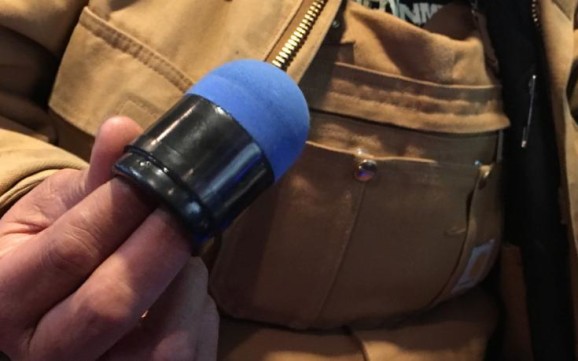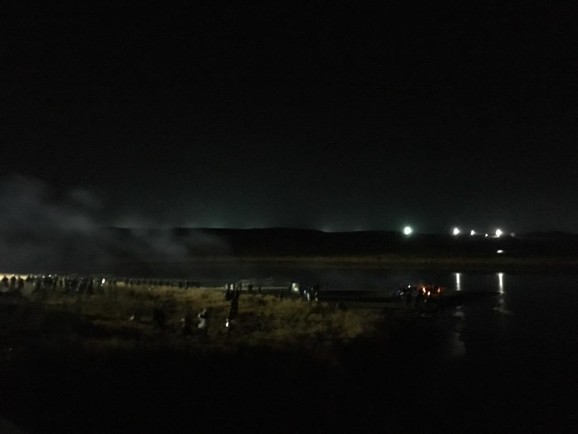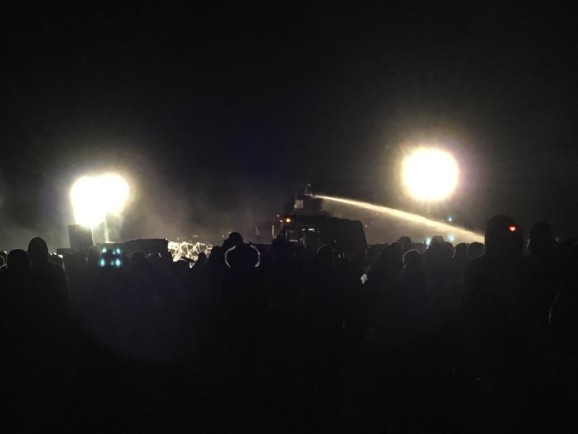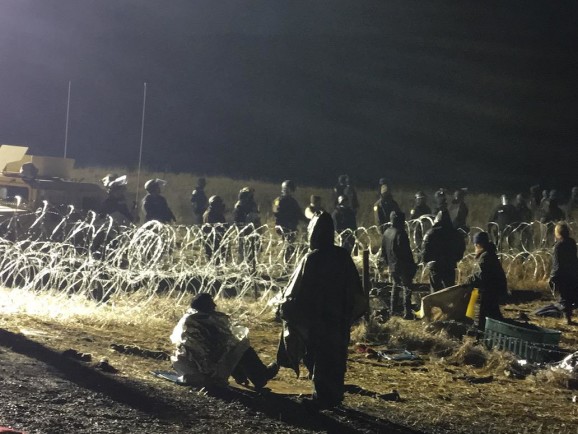Water Cannons, Tear Gas, Rubber Bullets, And Concussion Grenades Unleashed On Activists At Standing Rock
Police respond to Dakota Access Pipeline resistance in force, injuring 168.
Nov 22, 2016 | Photos and video by Gwendolyn Cates

Around 6 P.M. on Sunday, November 20, Elizabeth Hoover, 38, was preparing a wild rice and hominy salad in Grandma’s Kitchen, one of 10 canteens set up to feed the approximately 3,000 activists based at Standing Rock camp in North Dakota. They had gathered there to resist the proposed Dakota Access Pipeline (DAPL), which, if built, would funnel crude oil from nearby tar sands beneath the Missouri River to Illinois, 1,172 miles away. Hoover—a professor of American studies at Brown University—was finishing up her first full day at Standing Rock. She and a dozen others were cooking dinner when someone ran in and announced that bodies were needed at Backwater Bridge, roughly a quarter mile away.
Just a half hour earlier, a small group of activists had attempted to remove a burned-out vehicle in an effort to provide access to ambulances as winter took hold. It was 25 degrees and dropping, and the vehicle had been one of a few blocking the road since late October, when activists were forced off the disputed construction site and back to their camp in a crackdown that made international news.
When they attempted to remove the vehicle, the group was pushed back by fire hoses, which triggered an angry response from a small knot of activists gathered there. As word spread, their numbers grew. Soon there were almost 500 facing down about 100 sheriff deputies and a tactical SWAT team, along with their intimidating collection of Humvees, armored personnel carriers, and fire trucks. They were separated from one another by a concrete-and-barbed-wire barricade that the Morton County Sheriff Department had built on its side of the bridge to block further access to the pipeline site.
Hoover stopped on a hilltop above the bridge, where a screen had been set up to stream live drone footage. She saw water cannons deploy, drenching the activists, whose clothes began to freeze. She knew that one of her current students and two alums were in the mix, so she ran toward the front line to make sure they were safe. She had no idea she would be part of a standoff that would last over seven hours.
Phil Gilbert, 55, a Lakota Sioux from nearby Cheyenne River, has been camped at Standing Rock since August. He arrived at the scene at around 8:30 P.M. “It was already going strong by then,” he said. “The conflict went off in waves. The police had a continuous line all the way across, and when people would get too close to them on one side, they started using water cannons, and that would inspire people to want to confront them. Then it would calm down, and activists would get too close on the other side. Some of [the activists] had shields and everything.”
Konwenni Jacobs, 36, from the Mohawk Nation in Kahnawake, Quebec, was among the activists who used found plywood and scrap metal sheeting to deflect water. She and 10 others formed a wall, though they still got soaked. Occasionally, she would peek around the side of her makeshift shield and watch police as they stopped using water and used pepper spray instead. “They were holding mace canisters the size of little fire extinguishers,” she said. Those are designed for shorter distances, but the police also deployed tear gas canisters and even fired foaming mace from what an army veteran-turned-activist described as a “mace cannon.” A few enraged activists began hurling empty canisters back at police who responded with rubber bullets shot indiscriminately into the crowd. “When they shot people with bullets,” Jacobs said, “one [of the deputies] was laughing.”
Video taken at Standing Rock on November 20, 2016


Gilbert was shot in the leg three times. He’d come to the aid of a young man who had fallen and was being sprayed with a water cannon and couldn’t get to his feet. “I went over to raise hell so he could get up and get out of there,” Gilbert said. “[My legs] went numb, but I didn’t fall. I just backed off. It was like that all night. One girl got shot in the face. She had a bloody nose, a bloody mouth.” Gilbert, Hoover, and Jacobs all said they saw and heard concussion grenades deployed by law enforcement as well. “I saw three (grenades) lobbed in the air. They went off all around us,” Gilbert said.
Hoover shot footage and posted to her Twitter account (@bluefancyshawl) throughout the night, and was caught in a haze of tear gas more than once. She said the gas was used at least eight different times before tempers calmed at around 1 A.M.
As events unfolded, the Morton County sherriff released a statement calling the situation a riot instigated by protestors (activists prefer to be called water protectors). The department claimed that activists had deliberately lit fires in an attempt to harm officers, which is why they used fire hoses.
“It’s a peaceful protest. We don’t use weapons or have them. They are the ones who have the weapons and are blasting people.”
“They put out a fire that was started to warm people who had been drenched and were freezing,” Hoover responded.
“The only fires set were campfires,” Jacobs said, “That’s all that I saw. It was freezing. There was ice on the barbed wire.”
Police also contend that they used tear gas and rubber bullets to prevent people from crossing the bridge, a contention activists also dispute.
“Nobody was trying to cross over,” said Gwendolen Cates, a documentary filmmaker who has made several trips to Standing Rock since August and was on the scene most of the night. “You can’t anyway. There’s a barbed-wire-and-concrete barrier.” If activists had been crossing the barrier, one would assume they’d have been arrested for trespassing, but the sheriff’s department announced just one arrest.

There were plenty of injuries, however. According to sources, 12 were either critically wounded or sustained head injuries, and rushed to the hospital. A total of 168 were treated for hypothermia and pepper spray exposure on site by volunteer medics. Others were examined for concussions, or to see if they’d broken a bone after being hit with rubber bullets, which left some with palm-size welts. Still others were hit with grenade shrapnel. One young woman had her forearm torn open by a grenade. Her wound became frostbitten in the cold, and she may lose her arm. All because of decisions made by law enforcement officials with seemingly no regard for the Constitution.
“It’s a peaceful protest,” Gilbert said. “We don’t use weapons or have them. They are the ones who have the weapons and are blasting people.”
Cates, who has reported from Iraq multiple times, called it “a war zone.”

The pipeline is being built and operated by a North Dakota oil and gas logistics firm called Energy Transfer Partners in conjunction with Sunoco Logistics. Last September, President Barack Obama asked the company to voluntarily halt construction on one section of the pipeline and ordered the Army Corps of Engineers to examine alternative routes. With Donald Trump headed to the White House, all that could change. According to financial disclosures made during his campaign, Trump has invested between $500,000 and $1 million in Energy Transfer Partners, who in turn donated $100,000 toward his campaign—yet another reason why so many on both sides of the political aisle have called on Trump to divest and liquidate all of his holdings before he takes office.
If the project does go forward, the Morton County Sheriff Department and Energy Transfer Partners will have to deal with the thousands who continue to gather at Standing Rock. On Monday, a group of them locked arms and blocked the road in front of the sheriff’s headquarters in Mandan, North Dakota. Sixteen were arrested.
“The call went out [for support],” Gilbert said, “and it was for everybody. We got people from [all over the world] at this camp.” Gilbert is from the next reservation south. It took him less than three hours to drive here with his 77-year-old mother, and they have no plans to leave, which, given the stakes, means he’s likely to see more nights like November 20. That’s a chance he’s driven to take.
“If this thing leaks and it goes into the water, it comes right through us,” he said. “We plan on staying here through the duration. Whatever it takes.”